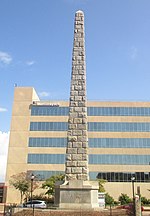The Arras
1965 establishments in North CarolinaBuildings and structures in Asheville, North CarolinaCondo hotels in the United StatesHotels in North CarolinaNorth Carolina building and structure stubs ... and 1 more
Skyscrapers in Asheville, North Carolina

The Arras is the tallest building in Asheville, North Carolina with 19 stories and 201,000 square feet. It was built in 1965 as the Northwestern Bank Building and was later called the BB&T Building. In 2019, it reopened as the Art Deco style Kimpton Hotel Arras on floors 1 to 9, and Arras Private Residences condominium complex on floors 10-19 after a major renovation. The building is 228 feet tall.
Excerpt from the Wikipedia article The Arras (License: CC BY-SA 3.0, Authors, Images).The Arras
Patton Avenue, Asheville
Geographical coordinates (GPS) Address Nearby Places Show on map
Geographical coordinates (GPS)
| Latitude | Longitude |
|---|---|
| N 35.59518 ° | E -82.55221 ° |
Address
Patton Avenue 7
28801 Asheville
North Carolina, United States
Open on Google Maps








